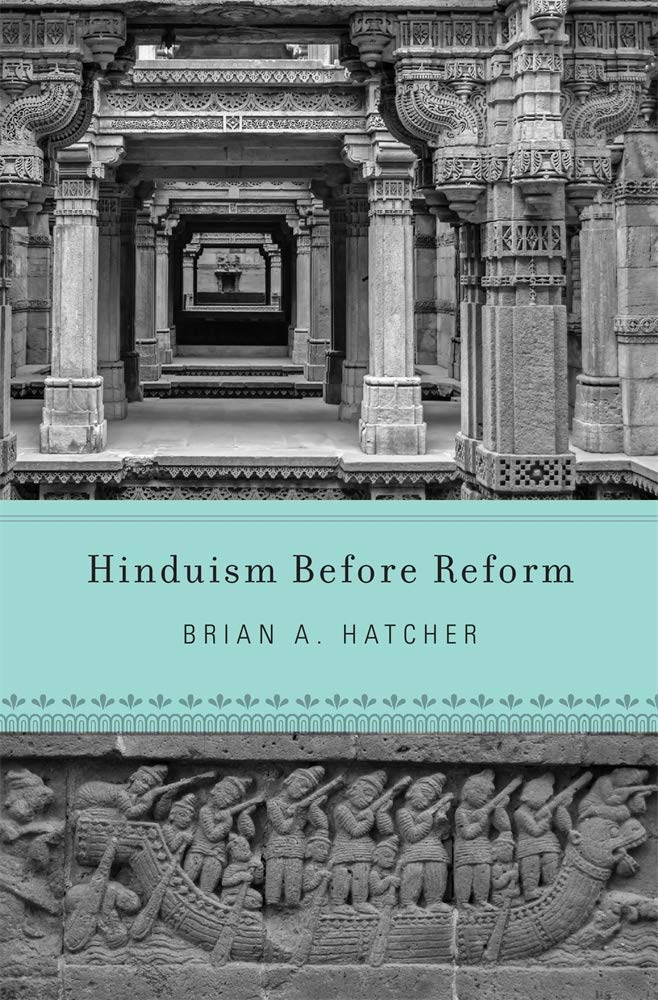BOOK: Hinduism Before Reform
AUTHOR: Brian A. Hatcher
PUBLISHER: Harvard
PRICE: $39.95
Brian Hatcher is a Professor of Theology in a Department of Religion. That eminently qualifies him to write a book with the ambitious title of Hinduism Before Reform, with all three words capable of varied interpretation. As we move along, through nine chapters and an Introduction, we realize the aspiration is more limited. It is to bring down Sahajanand Swami (Swaminarayan Sampraday) and Rammohun Roy (Brahmo Samaj) a peg or two since they have been subject to too much of hagiography. Accordingly, the book appropriately begins with a quote from Macbeth. “And sundry blessings hang about his throne, That speak him full of grace.” Those words were spoken by Malcolm and befittingly Hatcher will bring a “swoll’n and ulcerous” eye to bear on these two historical figures, an eye that is presumably objective, to the extent that history can ever be objective. There is no book that analyses Sahajanand Swami and Rammohun Roy in comparative perspective. Hence, here is a volume with value addition. Or so runs the argument. “As we shall see, the reasons for this strange oversight [of lack of comparison] are anything but trivial.” This is a sentence from the Introduction, right at the beginning of the book. Do notice the use of the word, “we”. What’s strange about it? It’s standard academic practice.
“Then he reminded his followers that Parvati is important ‘for us’ (asmakam). The modest Sanskrit pronoun encodes a savvy act of boundary-making.” This is a remark on Sahajanand and his skill at positioning his new polity. By the author’s logic, “we” are a distinct polity, and the followers should take care to avoid demonic (asura) deities that violate “‘our’ norms”. Since the Professor claims (in the Preface) he has consulted Sanskrit texts, he must be familiar with the standard usage of asmakam, no more unusual than the regal and professorial use of “we”. Before the book’s core, the Introduction provides scope for holding forth on assorted matters. Martha Nussbaum is singled out for some stick in the Introduction. “Equally surprising, however, is how casually an accomplished scholar [Nussbaum] tosses around terms like sect, cult, indoctrination, and authoritarian.” As another accomplished scholar, Hatcher should adhere to the same yardstick. “How significant is the threat posed to democratic life by forces of religious fanaticism, ethno-nationalism, and autocratic or (what some would call) fascist modes of political leadership?... In the era of Donald Trump, Brexit, and the Bharatiya Janata Party, such questions cannot be ignored.” The tar on the feather is the same. “By design, this book has more to say on the topic of historical origins than on the contemporary scene.” If so, those generalizations and platitudes in the Introduction weren’t necessary, especially since they involve inaccuracies. No, the Hindu Swayamsevak Sangh is not an overseas branch of the Indian Rashtriya Swayamsevak Sangh and it is remarkably easy to check. A PhD student who did this would have failed a course in research methodology.

Hinduism Before Reform by Brian A. Hatcher, Harvard, $39.95 Amazon
Ignoring the contemporary scene (Introduction), the PhD student on historical origins (other nine chapters) also fails the course in research methodology. The seven oceans of Hindu cosmology had salt-water, sugarcane juice, liquor, ghee, curd, milk and fresh water. Every translator will use some variation of these words. Unless one has Alice in Wonderland in mind, I don’t think anyone will use the word, treacle. One has every right to dismiss Hindu cosmology. But once one quotes Thomas Babington Macaulay and his translation of “seas of treacle” to ridicule Puranic geography, I think there is a serious academic credibility problem. Macaulay on the history of England or the Indian Penal Code is fine, but on Puranic geography?
A person who claims to have checked Sanskrit sources no doubt knows Sanskrit. In the process of establishing the clay feet Sahajanand Swami and Rammohun Roy possessed, Hatcher argues they were lordly and hierarchical. Hence, “the Sanskrit term dakshinya — a complex ethical category that captures a ruler’s ability to be kind, but to do so in a way that is skillfully attuned to the importance of hierarchical protocols and the demands of balancing the display of affection and the bestowing of favors.” Since that word was constantly used for Raja Rammohun Roy, “We may appreciate how both Persianate and Sanskritic courtly norms converged in his lordly demeanor as generous and high-minded.” Sanskrit words do have multiple meanings. But whichever lexicon one uses, I don’t think anyone will go beyond dexterity, politeness, kindness, courtesy or sacrificial fee to bring in a lord and his manor. There is a curiously cavalier attitude to objectivity, research and scholarship. If one is going to quote Manu on women, one shouldn’t selectively quote verses that suit one’s proposition and ignore those that don’t. “Manu requires three Brahmins, learned in the Vedas, and an officer of the king; this, he says, constitutes the ‘court of Brahman.’”The brahman is the paramatman. This is Brahma’s court. True, the translation quoted is by someone else. But I thought the Sanskrit was being checked.
The book begins with the sentence, “Here is a strange but telling fact.” It is a strange but telling fact that this book has been published.










